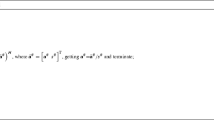Abstract
The linearly constrained least squares constant modulus algorithm (LSCMA) may suffer significant performance degradation and lack robustness in the presence of the slight mismatches between the actual and assumed signal steering vectors, which can cause the serious problem of desired signal cancellation. To account for the mismatches, we propose a doubly constrained robust LSCMA based on explicit modeling of uncertainty in the desired signal array response and data covariance matrix, which provides robustness against pointing errors and random perturbations in detector parameters. Our algorithm optimizes the worst-case performance by minimizing the output SINR while maintaining a distortionless response for the worst-case signal steering vector. The weight vector can be optimized by the partial Taylor-series expansion and Lagrange multiplier method, and the optimal value of the Lagrange multiplier is iteratively derived based on the known level of uncertainty in the signal DOA. The proposed implementation based on iterative minimization eliminates the covariance matrix inversion estimation at a comparable cost with that of the existing LSCMA. We present a theoretical analysis of our proposed algorithm in terms of convergence, SINR performance, array beampattern gain, and complexity cost in the presence of random steering vector mismatches. In contrast to the linearly constrained LSCMA, the proposed algorithm provides excellent robustness against the signal steering vector mismatches, yields improved signal capture performance, has superior performance on SINR improvement, and enhances the array system performance under random perturbations in sensor parameters. The on-line implementation and significant SINR enhancement support the practicability of the proposed algorithm. The numerical experiments have been carried out to demonstrate the superiority of the proposed algorithm on beampattern control and output SINR enhancement compared with linearly constrained LSCMA.
Similar content being viewed by others
References
Fares S. A., Denidni T. A., Affes S., Despins C. (2008) Fractional-delay sequential blind beamforming for wireless multipath communications in confined areas. IEEE Transactions on Wireless Communications 7: 629–638
Yang J., Xi H. S., Yang F., Zhao Y. (2006) Fast adaptive blind beamforming algorithm for antenna array in CDMA systems. IEEE Transactions on Vehicular Technology 55: 549–558
Song X., Wang J. K., Wang B. (2010) Robust adaptive beamforming under quadratic constraint with recursive method implementation. Wireless Personal Communications 53: 555–568
Yao H., Wu Y. (2010) Broadband beamspace constant modulus array. Systems Engineering and Electronics 32: 266–268
Yu Z. L., Ser W., Er M. H. et al (2009) Robust adaptive beamformers based on worst-case optimization and constraints on magnitude response. IEEE Transactions on Signal Processing 57: 2615–2628
Bell K. L., Ephraim Y., Van Trees H. L. (2000) A Bayesian approach to robust adaptive beamforming. IEEE Transactions on Signal Processing 48: 386–398
Van Veen B. D. (1991) Minimum variance beamforming with soft response constraints. IEEE Transactions on Signal Processing 39: 1964–1972
Frost III O. L. (1972) An algorithm for linearly constrained adaptive processing. Proceeding of IEEE 60: 926–935
Zhang S., Thng I. L. (2002) Robust presteering derivative constraints for broadband antenna arrays. IEEE Transactions on Signal Processing 50: 1–10
Feldman D., Griffiths L. (1994) A projection approach for robust adaptive beamforming. IEEE Transactions on Signal Processing 42: 867–876
Carlson B. D. (1988) Covariance matrix estimation errors and diagonal loading in adaptive arrays. IEEE Transactions on Aerospace and Electronic Systems 24: 397–401
Li J., Stoica P., Wang Z. (2004) Doubly constrained robust Capon beamformer. IEEE Transactions on Signal Processing 52: 2407–2423
Nai S. E., Ser W. et al (2011) Iterative robust minimum variance beamforming. IEEE Transactions on Signal Processing 59: 1601–1611
Vorobyov S. A., Gershman A. B., Luo Z. Q. (2003) Robust adaptive beamforming using worst-case performance optimization: A solution to the signal mismatch problem. IEEE Transactions on Signal Processing 51: 313–324
Elnashar A. (2008) Efficient implementation of robust adaptive beamforming based on worst-case performance optimisation. IET Signal Processing 2: 381–393
Lei L., Lie J. P. et al (2010) Robust adaptive beamforming in partly calibrated sparse sensor arrays. IEEE Transactions on Signal Processing 58: 1661–1667
Zheng G., Ma S. et al (2010) Robust beamforming in cognitive radio. IEEE Transactions on Wireless Communications 9: 570–576
Agee, B. G. (April 1986). The least-squares CMA: A new technique for rapid correction of constant modulus signal. In Proceeding of ICASSP 1986, pp. 953–956, Tokyo.
Himawan I., McCowan I., Sridharan S. (2011) Clustered blind beamforming from Ad-Hoc microphone arrays. IEEE Transactions on Audio Speech, and Language Processing 19: 661–676
Huang X. Z., Wu H. C., Principe J. C. (2007) Robust blind beamforming algorithm using joint multiple matrix diagonalization. IEEE Sensors Journal 7: 130–136
Meng Y., You M. L., Luo H. W., Liu G. (2010) The linearly constrained CMA for blind multi-user detection. Wireless Personal Communications 53: 199–209
Le K. N. (2009) On angle-of-arrival and time-of-arrival statistics of geometric scattering channels. IEEE Transactions on Vehicular Technology 58: 4257–4264
Hodgkiss W. S., Nolte L. W. (2000) Optimal array processor performance trade-offs under directional uncertainty. IEEE Transactions on Aerospace and Electronic Systems 12: 605–615
Sansrimahachai P., Ward D. B., Constantinides A. G. (2005) Blind source separation of instantaneous MIMO systems based on the least-squares constant modulus algorithm. IEE Vis. Image Signal Processing 152: 616–622
Author information
Authors and Affiliations
Corresponding author
Rights and permissions
About this article
Cite this article
Song, X., Wang, J., Li, Q. et al. Robust Least Squares Constant Modulus Algorithm to Signal Steering Vector Mismatches. Wireless Pers Commun 68, 79–94 (2013). https://doi.org/10.1007/s11277-011-0440-2
Published:
Issue Date:
DOI: https://doi.org/10.1007/s11277-011-0440-2




